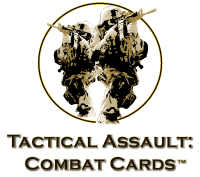Designer Q&A…
In this installment a couple of questions about deploying forces in the Combat Cards are discussed…
When my friend and I play a game, we usually just deploy our forces along our table edges and set out some objectives in the middle of the table. Unfortunately our battles always seem to end in a stalemate, with neither of us able to get to any of the objectives – we instead just sit and shoot at each other. Are we doing something wrong?
You really aren’t doing anything wrong; it is just that the rules are just working the way they are supposed to. As can be seen in numerous historical examples, moving in the face of a concentrated enemy force is usually going to prove costly and fruitless.
Whenever folks deploy along an edge of a battlefield they are in effect setting up “gun-lines”, a powerful formation created when a mixture of long and short range weapons interweave their fields of fire to make movement on the battlefield almost impossible.
(Some good historical examples of gun lines being used with great effect include the Rommel’s use of a gun line to stop the British attack at Arras in France 1940, Rommel’s use of them again in the North African campaigns of 1941/42 as well as the Russian use of the so called “Pak Front” gun lines to blunt German advances during the battle of Kursk.)
In the world of modern combined arms the best way to defeat a known gun line is simply to go around it – which is usually beyond the scope of your average tabletop battle – or to sit back and use artillery and air power to disrupt and destroy the line, which unfortunately doesn’t exactly sound like an exciting night of gaming.
That is why the Standard Game deployment method was developed. By allowing players as much flexibility in deploying their units as possible, situations like the dreaded gun-line almost never come about – it is just too easy to thwart them during set-up. It was also found that granting more latitude during deployment almost always resulted in a much more interesting (and often more realistic) battle.
The deployment described in the Standard Game seems like an almost random way of placing forces. Why was that method chosen?
On the surface, the Standard Game deployment does appear to be a bit random. In the end though, it does a pretty good job of emulating the messy nature of the front line at a tactical level.
In most real world situations, the front lines are usually very fluid at the tactical level – listening and observation posts are often pushed as far forward as possible; key terrain features are held on to even if they form a salient in the line; positions which are hard to defend may be conceded to the enemy to improve the defensibility of the front line, etc.
Add to this the inevitable shifting of units that occurs prior to an attack, the creation of staging areas close to the front and the launching of small scale preliminary attacks designed to secure key pieces of terrain or jumping off points, and the likelihood of neat and tidy front lines are very remote.
The Standard Game deployment method was designed to incorporate all of the above tactical factors in a simple and easy to use mechanic. By allowing players to select just about any location on the battlefield to deploy a unit, they are afforded some flexibility in preparing for the battle. But, by requiring the players to deploy their units at least a Medium distance away from deployed enemy units, they are still restricted in what they can actually get accomplished due to the enemy’s dispositions. The net result is usually a complex (and interesting) situation with advantages and disadvantages that each side will have to find ways to deal with.
In addition, the choices you face in the deployment phase of the Standard Game create another whole challenging game within the game: Should you secure key terrain for your units, or simply aim to deny your enemy the terrain they most covet? Should you scatter your forces in search of localized advantages over enemy units and risk piecemeal destruction of your own units, or should you concentrate your forces and face the possibility of a bitter battle of attrition? And so on…
Ultimately, the goal was to make deploying your forces an important and interesting part of the battle. Experience showed that by allowing a significant amount of flexibility in the initial deployment, the likelihood of having fun and interesting games that are still very realistic increased dramatically.
And in the end, isn’t a fun and interesting game what it is all about…





